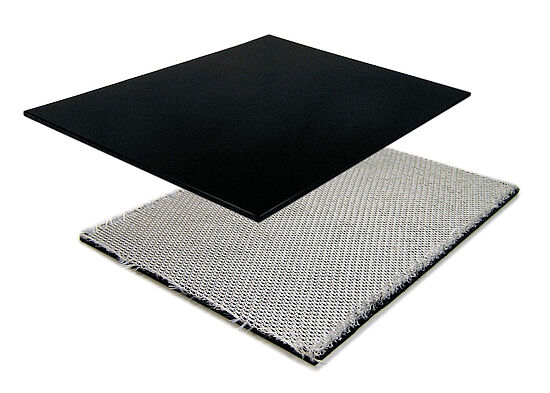Röchling offers a comprehensive range of ESD materials • A favourite experiment in the physics lesson is one where an electrostatic charge is applied to plastic film by means of friction. Likewise, in many areas of industry plant parts can be charged electrostatically by means of friction. When these voltages discharge, humans may be at risk or in areas prone to fire risk dust and gases may be ignited by sparkovers. Static charges may also be the cause of electromagnetic faults on sensitive equipment. Electrically conductive and antistatic plastics can help here.
Plastics with defined electrically conductive properties can dissipate electrostatic charges controlledly and lastingly. They are used in many areas of industry, such as the electronics and semi-conductor industry, ventilation, ventilator and pump construction, medical technology, the chemical and pharmaceutical industry, grain mills and other industries where bulk goods generate dust, the handling of flammable liquids and gases, e.g. at petrol stations, at airports and gas plants, the paper industry, fabric or film manufacture or mining. Thanks to its very many and varied property profiles the Röchling product range offers the highest level of safety for these applications.
If a discharge generates the necessary ignition energy in potentially explosive environments, known as EX zones, sparks may be discharged and the explosive materials thus ignited. The European ATEX (from French "ATmosphère EXplosive") directive 94/9/EC contains regulations for the use of components and systems in potentially explosive environments.
A human feels electrostatic discharges as a short electric shock only from 3000 volts up. Component parts used in the electronics and semi-conductor industry are much more sensitive. Even discharges of considerably less than 100 volts can affect or even destroy sensitive component parts (ESDS= electrostatic discharge sensitive devices). The result is lasting damage to or immediate failure of the component part. Materials coming into contact with such sensitive electronic components must therefore have electrically dissipative properties.
The Röchling High Performance Plastics Group offers areas of industry which make use of the electrical conductivity of plastics a wide range of technical and high performance plastics. As well has "conventional" properties like outstanding chemical resistance, very high sliding properties or high abrasion resistance, flame retardant or self-extinguishing characteristics or suitability for use at high temperatures, they also have a specified electrical property - from antistatic to conductive.
PRODUCT RANGE
Polystone® PPs EL
- Polypropylene (PP)
- Flame retardant
- electrically conductive
- resistant to chemicals
- as press moulded or extruded sheet
- extruded sheets also with polyester stretch coating on the rear side
NEW!
Polystone® PPs EL GK
- as Polystone® PPs EL
- Coating with knitted glass fibre, improved bonding properties for use at high temperatures (up to 90 °C)
Polystone® G-black EL
- Polyethylene (PE)
- electrically conductive
- resistant to chemicals
- as press moulded or extruded sheet
- extruded sheets also with polyester stretch coating on the rear side, enabling bonding to other materials
Polystone® M (PE-UHMW), Polystone® D (PE-HD)
- press moulded sheet
- available in antistatic AST and electrically conductive EL version.
Polystone® PVDF EL
- electrically conductive PVDF
- highly resistant to chemicals
- high continuous-use temperature
SUSTAPEI ESD 60, SUSTAPEI ESD 90 (PEI)
- electrically conductive (or electrostatically dissipative) PEI on the basis of carbon-nanotubes or other additives
- high rigidity and strength
- high surface hardness
- suitable for a wide temperature range
SUSTAPEEK ESD 60 (PEEK)
- electrically conductive carbon-nanotube-based PEEK
- low particle abrasion compared with soot- or graphite-filled ESD materials
- high strength, rigidity and hardness
- excellent resistance to chemicals
- excellent dimensional stability
- lowly flammable and self-extinguishing
- high sliding capacity and abrasion resistancehigh resistance to hot forming
- extremely high continuous-use temperature
SUSTAPEEK CF 30 (PEEK)
- electrically conductive, carbon-fibre-filled PEEK
- excellent rigidity and strength over a wide temperature range, high hardness
- excellent resistance to chemicals
- excellent dimensional stability
- lowly flammable and self-extinguishing
- high resistance to hot forming
- extremely high continuous-use temperature
SUSTAPVDF ESD 60 (PVDF)
- electrostatically conductive PVDF
- excellent toughness with medium rigidity and strength
- excellent resistance to chemicals
- flame retardant or self-extinguishing
- high continuous-use temperature
SUSTAMID 6 ESD 60 (PA 6)
- electrostatically conductive PA 6
- excellent sliding capacity
- high mechanical strength
SUSTAMID 6G ESD 90 (PA 6 G)
- electrostatically dissipative PA 6 G
- excellent sliding capacity
- high mechanical strength
- available as semi-finished product and as near net shape casted part
SUSTARIN C ESD 60 (POM)
- electrostatically conductive POM copolymer
- excellent sliding capacity
- well-balanced combination of rigidity, strength and toughness
- low moisture absorption
- high dimensional stability
SUSTARIN C ESD 90 (POM)
- electrostatically dissipative POM copolymer
- reduced contamination risk, because soot- and graphite-free
- good toughness with medium rigidity and strength
- low moisture absorption
- high dimensional stability
SUSTARIN C ESD 90 PLUS (POM)
- electrostatically dissipative POM copolymer
- Surface resistance compared with SUSTARIN ESD 90 again reduced and within narrower limits (107 up to 109 Ohm)
- reduced contamination risk, because soot- and graphite-free
- good toughness with medium rigidity and strength
INSULATION BEHAVIOUR
The insulation characteristics of a material are defined by its resistance to a current flowing through it. Continuity resistance applies only to the current flowing through the interior of the material and not to the part of the current flowing over the surface. The surface resistance measured between two electrodes applied to the surface of the material also applies to part of the current flowing on the inside.
For assessing the suitability of a material for an ESD application (ESD = ElectroStatic Dissipation) surface resistance is the more important of the two characteristics, because it decisively affects the electrostatic charging and discharging of a material. When selecting material, it must be ensured that the material used is not electrostatically chargeable, that is, the surface resistance is lower than 109 Ω.
Surface resistance can be subdivided into three levels of resistance:
Electrostatically conductive
Materials with surface resistance values lower than 106 Ω are electrostatically conductive. These materials are able to dissipate in the shortest possible time charge carriers applied to them. Because of the very short discharge time conductive materials are not suitable for all ESD applications, because the voltage peaks occurring here may cause damage, particularly to electrostatically sensitive electronic components.
Electrostatically dissipative
Materials are described as electrostatically dissipative, if their specific surface resistance is between 106 Ω and 1012 Ω. Such materials are able to dissipate within a specified time charge carriers applied to them. These materials are only limitedly chargeable. Materials with a surface resistance lower than 109 Ω are not chargeable.
Insulating
Materials with a specific surface resistance higher than 1012 Ω are described as insulating. Insulators have very low conductivity. For this reason applied charge carriers remain on the surface of these materials for a long time and are dissipated only slowly. Charges of many thousands of volts are thus possible without difficulty. Insulating materials are unsuitable for ESD applications.
Continuity resistance








